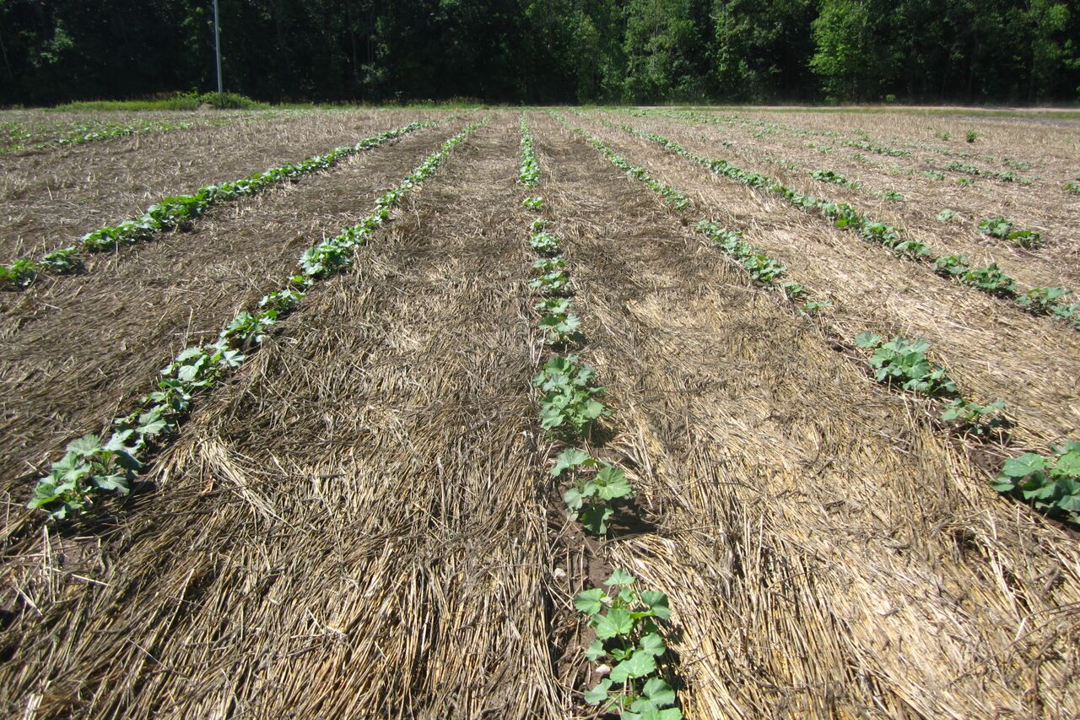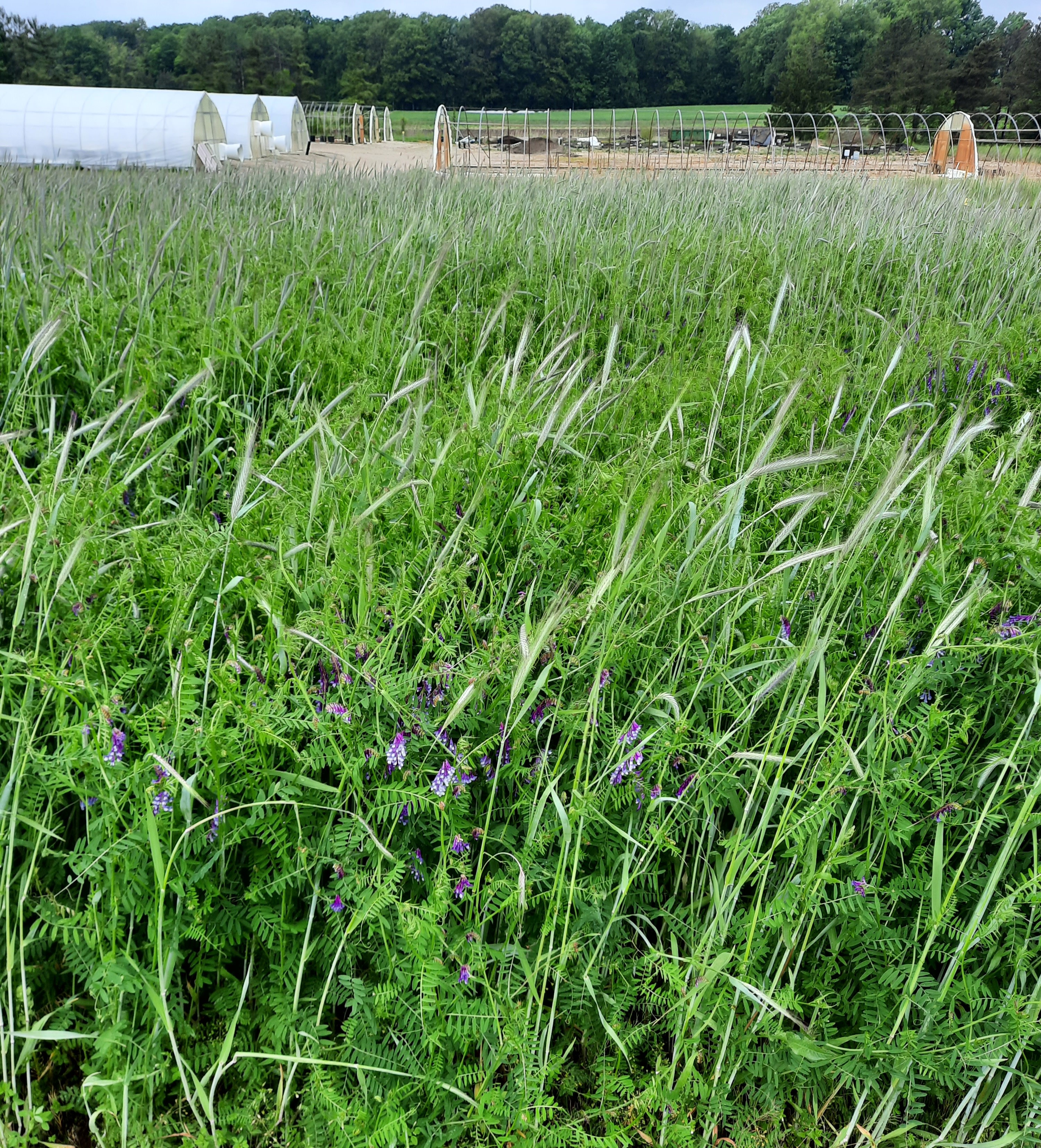Cover crop considerations for vegetables
Integrating cover crops into your vegetable rotation can offer many benefits for crop and soil health.

Cover crops offer a variety of well-established agroecosystem benefits. They can improve soil health and quality by minimizing erosion, busting compacted soil layers, and adding organic matter, which aids in water retention and buffering harmful drought conditions. They can be used to increase nutrient availability by scavenging or fixing elements like nitrogen. They can be used to combat pests by suppressing weeds, providing habitat for natural enemies, or through use as a biofumigant. These examples demonstrate a few of the diverse benefits that can be achieved by integrating cover crops into your production system.
There are three main groups of cover crops: grasses, legumes, and brassicas. Apart from the big three, there are also many other species that do not fit into the main categories, such as buckwheat, sunflowers, and phacelia. Cover crops can be knowledge intensive as every different species offers a variety of benefits and constraints. You can find more information at the Midwest Cover Crop Council’s website and in Managing Cover Crops Profitably published by SARE.
With that said, there are reasons that a grower might decide cover crops are not right for their operation. One of the biggest barriers to adopting cover cropping is the cost involved in purchasing inputs (seed and any specialized equipment) and labor required for managing the cover crop. Organizations like the Natural Resource Conservation Service (NRCS) offer cost-share opportunities to help farmers include cover crops which would otherwise be cost-prohibitive. Pest issues can also be amplified by having certain cover crops in rotation. Increased living cover on your fields can provide habitat for pests like slugs and rodents, which can feed on vegetable crops. Responsive actions to take include applying molluscicides for slug control or providing predator perches to support raptor hunting of varmints in the field. Cover crops can also be a host for vegetable crop pathogens. One example is the soilborne disease clubroot which infects cole crops. Growing a brassica cover crop could serve as an additional source of inoculum for the pathogen, extending its survival in the soil. Incomplete termination of a cover crop can also lead to weed problems from surviving plants throughout the season. Late termination of cover crops after they have set/dispersed seed can lead to increased weed pressure in subsequent seasons. Poorly established cover crops may fail to fully suppress weeds, leading to weed infestation and seed production. The drawbacks of implementing cover crops can be remedied through experience, planning, and commitment.
Cover crop windows are expanded and varied in vegetable production compared to field crops due to the different crop maturity dates, planting timelines, and management goals. Below are six examples of cover crops used in vegetable production systems:
Cole Crops
Brassica cover crop options (radishes, mustards, turnips) would not typically be grown the same season as cabbage, broccoli, cauliflower, etc. as they can serve as alternate hosts for disease and insect pests. Instead, a grass species like cereal rye or a legume like clover can be used to add organic matter and/or N while keeping the soil covered over the winter. A common practice is to leave strips of a rye cover crop intact when preparing the soil after spring termination. These strips act as windbreaks to shelter young transplants from being blasted with soil particles moved by the wind. Rye or barley windbreaks are also used in carrots, peppers, melons, and other vegetable crops.
Cucurbits
No-till cucurbit production is a fairly popular system, where overwintered rye or rye/vetch mixtures are terminated and the crop, usually pumpkins or squash, is planted into the residues. The residue mulch suppresses weed emergence, retains soil moisture, adds organic matter, creates habitat for natural enemies of cucurbit pests (ex. wolf spiders for control of striped cucumber beetles), and keeps fruit from contacting bare soil which improves crop quality. However, success with this system does require specialized equipment and experience. If the cover crop stand is inadequate, winter annual and perennial weeds may establish. Crop development may also be delayed in cold wet years, as soils will warm up more slowly in the no-till system. When rye is used alone, increasing N fertilization by at least 30 pounds per acre may be necessary to compensate for N tied up in the rye.

Sweet Corn
Much work has been put into trying to solve the problem of cover crops following corn. Field corn requires the full season, drastically limiting cover crop options compared to a shorter crop like wheat or many vegetables. Solutions that have been developed include interseeding red clover into corn to fix N, add organic matter, and provide soil cover. Most sweet corn is harvested far earlier than field corn, leaving not only abundant residues but also a longer window for cover crops. Rye is of course an option, but other covers like mustard, oats, and radish can also put on an adequate amount of growth before they are frost-killed. The choice of which cover crop to use after corn will also depend on which crop will be planted the following year.
Potatoes
As potatoes benefit from being grown at an acidic pH (5.5 - 6.5), any preceding cover crops must be able to establish in and support low pH conditions. Potatoes require a relatively long time to mature, further limiting cover crop options after harvest. Cereal rye is a cover that tolerates acidic soils, establishes when planted in the fall, and is a biomass builder. As the heavy amount of soil disturbance needed for commercial potato production can deplete soil health, selecting cover crops that return organic matter to the soil is a winning strategy.
Tomatoes
Tomatoes can benefit from cover crops to varying extents based on the type of production system. High-tunnel tomatoes are not subject to the erosive power of wind and rain, making cover cropping a lower priority under plastic. Processing tomatoes grown out in the field stand to benefit more from implementing a cover crop to prevent erosion, suppress weeds, add organic matter, and provide other services. A oats/radish mix can do well in processing tomato systems as the cover crops establish well in the fall and will usually winter kill.
Snap Beans
With a short-season crop like snap beans, the choices for cover crops are expanded and can be driven by management goals rather than timing constraints. A previous MSU Extension article outlines strategic cover crop selections for snap beans. If your priorities are weed suppression while still building organic matter, a mix of oilseed radish and oats can work well. If your priority is to minimize root diseases and plant stressors contributing to reduced bean establishment, using a grass like rye or sorghum-sudangrass can provide a number of benefits for maintaining soil and crop health.
Cover crop management
Cover crops that winter kill and decompose quickly in the spring are good choices for early spring crops like lettuces and early brassicas. Winter killed crops should be planted earlier than their overwintering counterparts in order to get benefits from the cover crop. A good fit for these cover crops would be vegetables that are harvested in late summer/early fall like cucumbers and sweet corn.
Winter hardy cover crops need to be terminated in the spring. Depending on your method of termination you should allow the appropriate amount of time to pass before you plant your cash crop. They are good to pair with crops that will be transplanted or can be planted later in the summer. Winter hardy cover crops can be planted early to late fall and are good to follow late- harvested crops like tomatoes and peppers.

Cover crops can also be planted in midsummer as many vegetable crops are harvested at or before this time. You should consider your goals for your system to match the most appropriate cover crop to the needs of your soil and your crop management. According to Natalie Hoidal from the University of Minnesota, “If your goal is to produce as much biomass as possible, the high carbon to nitrogen ratio crops are great choices for adding organic matter to your soil. However, they will take longer to decompose, and so they are best suited for fields where you do not plan to grow a late fall crop, as the breakdown process may tie up nutrients.” High carbon cover crops are plants like Sudex and sunflowers while moderate carbon plants to consider would be buckwheat and Phacelia.
Developing a termination strategy for cover crops is essential to the success of the management practice. You want to ensure that there is no interference with the following cash crop by the cover crop. There are three termination options to consider: winter kill, mechanical methods, and herbicides. You can learn more about these options in the extension bulletin Cover Crop Termination (MSUE CC-01) by Erin Hill and Christy Sprague.
An excellent resource is the Midwest Cover Crops Council (MCCC) website. This site is a wealth of knowledge on all things cover crops, with information on the different types, blends, and advantages for your cropping system. Particularly noteworthy is the MCCC Selector Tool for row crops. By inputting your farm’s details and production goals, you can view a breakdown of different cover crops options for your system and their merit in terms of meeting your chosen objectives. MCCC is also developing a selector tool designed specifically for vegetable producers, so keep an eye on the website for when that new program is available.
For more information about using cover crops in vegetables, please contact an MSU Extension Vegetable Educator for your region.



 Print
Print Email
Email